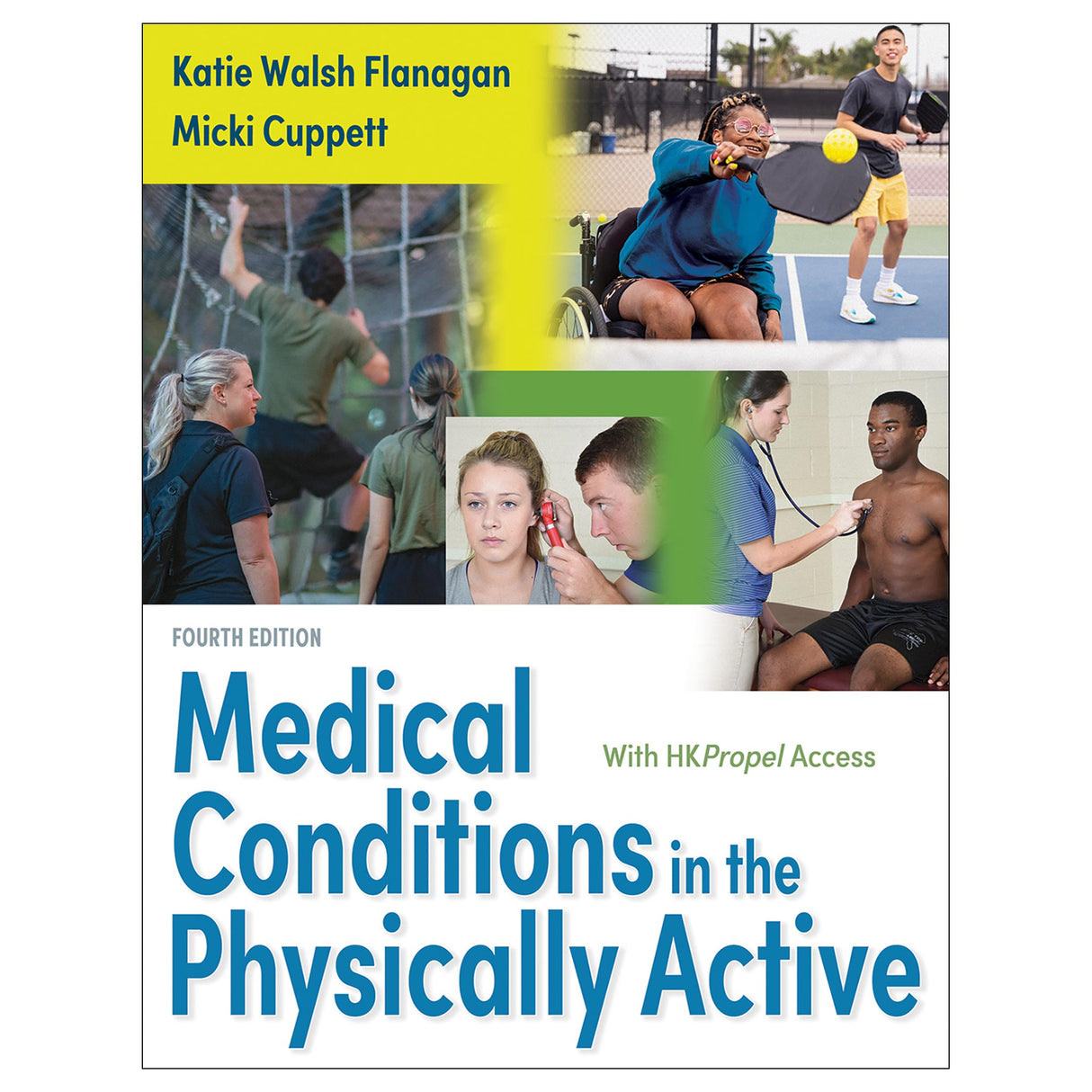Medical Conditions in the Physically Active 4th Edition Ebook With HKPropel Access
Author: Katie Walsh Flanagan, Micki Cuppett
$89.00 USD

Previously titled Medical Conditions in the Athlete, this fourth edition uses current research to offer assessment and treatment information for medical conditions that affect both athletes and active populations. The highly esteemed authors, Katie Walsh Flanagan and Micki Cuppett, have combined their professional skills and educational expertise to create a valuable athletic training resource with updated content that aligns with Board of Certification (BOC) and Commission on Accreditation of Athletic Training Education (CAATE) standards. The fourth edition offers the following updates:
- A new section on acute respiratory illnesses, including COVID-19 and SARS
- A new section on gastrointestinal disorders
- A new chapter on endocrine disorders
- Expanded content on concussion detection, treatment, and management, including return to play guidance
- New photos presenting medical conditions on diverse skin colors to help students learn identification skills
- Three case studies per chapter, delivered through HKPropel, to provide students with real-world examples; the case studies include multiple-choice questions that are assignable and automatically graded
At the beginning of the text, a Condition Finder serves as a quick reference so students or clinicians can easily flip to the information they need on specific conditions. Throughout the book, Red Flags for Urgent Intervention offer warning signs that health care providers should look for when working with patients; Clinical Tips discuss information that is critically important to professionals; and Condition Highlights cover specific medical conditions common to athletes and the physically active that require special attention or medical care.
Medical Conditions in the Physically Active, Fourth Edition With HKPropel Access, provides comprehensive medical information to help readers build a framework for decision making that will help them choose effective courses of treatment.
Note: A code for accessing HKPropel is included with this ebook.
Audience
Textbook for use in athletic training curriculums requiring courses such as general medical conditions, pharmacology, and primary care sports medicine; also suitable for use in physical therapy and other allied health care programs.Chapter 1. Medical Examination
Examination of the Patient With a Medical Condition
Physical Examination
Summary
Chapter 2. Diagnostic Imaging and Testing
Radiography: X-Rays
Radionuclide Bone Scan
Fluoroscopy
Computed Tomography Scan
Positron Emission Tomography Scan
Magnetic Resonance Imaging
Diagnostic Ultrasound
Laparoscopy
Colonoscopy
Endoscopy
Electromyography and Nerve Conduction Studies
Electrocardiography
Cardiac Event Monitor
Cardiac Stress Test
Urinalysis
Complete Blood Count
Lumbar Puncture
Pulse Oximeter
Summary
Part II. Pharmacology and Interventions
Chapter 3. Basic Principles of Pharmacology
Regulation of Pharmaceuticals
Pharmacology
Special Considerations for Athletes
Potential Drug Misuse
Supplements
Resources
Summary
Chapter 4. Drug Categories
Anti-Inflammatory Agents
Narcotic Analgesics
Local Anesthetics
Antibiotics
Antivirals
Antifungals
Bronchodilators
Antihistamines
Decongestants
Gastrointestinal Disorders
Antidiabetic Agents
Biologics
Supplements
Summary
Chapter 5. Common Procedures in the Athletic Training Clinic
Informed Consent
Preventing Infection
Asepsis and Aseptic Technique
Procedures Used to Close Lacerations
Joint Aspiration and Injection
Summary
Part III. Medical Conditions by System
Chapter 6. Respiratory System
Overview of Anatomy and Physiology
Evaluation of the Respiratory System
Asthma and Exercise-Induced Bronchospasm
Acute Respiratory Illnesses
Upper Respiratory Infections
Bronchitis
Chronic Obstructive Pulmonary Disease
Pneumonia
Pleurisy
Spontaneous Pneumothorax and Hemothorax
Tuberculosis
Lung Cancer
Summary
Chapter 7. Cardiovascular System
Overview of Anatomy and Physiology
Cardiovascular Adaptations to Exercise
Preparticipation Examination
General Evaluation of the Cardiovascular System
Sudden Cardiac Death
Hypertrophic Cardiomyopathy
Coronary Artery Abnormalities
Marfan Syndrome
Myocarditis
Congenital Aortic Stenosis
Mitral Valve Prolapse
Arrhythmias
Syncope
Hypertension
Deep Vein Thrombosis
Pulmonary Embolus
Peripheral Arterial Disease
Anemia
Hemolysis
Sickle Cell Trait and Sickle Cell Anemia
Summary
Chapter 8. Gastrointestinal System
Overview of Anatomy and Physiology
Evaluation of Abdominal Pain
Evaluation of the Athlete With Acute, Traumatic Abdominal Pain
Nausea, Vomiting, and Diarrhea
Viral Gastroenteritis
Food Poisoning or Bacterial Diarrhea
Parasitic Infection
Stress-Induced Gastrointestinal Symptoms
Constipation
Heartburn and Gastroesophageal Reflux Disease
Gastritis and Peptic Ulcer Disease
Irritable Bowel Syndrome
Celiac Disease
Inflammatory Bowel Diseases
Appendicitis
Cholecystitis and Cholelithiasis
Colorectal Cancer
Summary
Chapter 9. Genitourinary and Gynecological Systems
Overview of Anatomy and Physiology
Evaluation of the Genitourinary and Gynecological Systems
Kidney Stones
Sports Hematuria
Urinary Tract Infection
Urethritis and Cystitis
Human Immunodeficiency Virus and Acquired Immunodeficiency Syndrome
Genital Warts
Syphilis
Gonorrhea
Chlamydia
Testicular Torsion
Hydrocele
Varicocele
Testicular Cancer
Prostate Cancer
Vaginitis
Pelvic Inflammatory Disease
Dysmenorrhea
Amenorrhea
Mittelschmerz
Ovarian and Cervical Cancer
Breast Cancer
Pregnancy
Ectopic Pregnancy
Summary
Chapter 10. Neurological System
Overview of Anatomy and Physiology
Evaluation of the Neurological System
Pathological Conditions
Sport-Related Concussion
Stroke
Headaches
Seizure Disorder and Epilepsy
Vertigo
Amyotrophic Lateral Sclerosis
Bell’s Palsy
Rabies
Complex Regional Pain Syndrome
Summary
Chapter 11. The Eye
Overview of Anatomy and Physiology
Evaluation of the Eye
Refractive Error
Conjunctivitis
Corneal Abrasions
Corneal or Scleral Lacerations
Corneal and Conjunctival Foreign Bodies
Hyphema
Subconjunctival Hemorrhage
Eyelid Lacerations
Orbital Fracture
Retinal Tear and Detachment
Dislocated Contact Lens
Chemical Burns
Periorbital Contusion
Traumatic Iritis
Proptosis
Protective Eyewear
Summary
Chapter 12. Ear, Nose, Mouth, and Throat
Overview of Anatomy and Physiology
Evaluation of the Ear, Nose, Mouth, and Throat
Hearing Loss
Otitis Externa
Otitis Media
Ruptured Tympanic Membrane
Allergic Rhinitis
Nonallergic Rhinitis
Sinusitis and Rhinosinusitis
Deviated Septum
Epistaxis
Pharyngitis and Tonsillitis
Laryngitis
Oral Mucosal Lesions
Oral Candidiasis
Oral Cancers
Dental Disease
Dental Caries
Summary
Chapter 13. Systemic Disorders
Overview of Anatomy and Physiology of the Lymphatic System
Non-Hodgkin’s Lymphoma
Hodgkin’s Lymphoma
Leukemia
Lyme Disease
Raynaud’s Disease
Systemic Lupus Erythematosus
Fibromyalgia
Chronic Fatigue Syndrome
Multiple Sclerosis
Guillain-Barré Syndrome
Gout
Pseudogout
Rheumatoid Arthritis
Osteoarthritis
Osteomyelitis
Polymyositis and Dermatomyositis
Summary
Chapter 14. Infectious Diseases
Prevention of Disease Transmission
Transmission
Prevention
Influenza
Infectious Mononucleosis
Mumps
Rubeola
Rubella
Chicken Pox and Shingles
Hepatitis A to D
Streptococcal Infections
Staphylococcal Infections
Sexually Transmitted Diseases and Infections
Encephalitis
Zika Virus
Viral Meningitis
Acute Bacterial Meningitis
Summary
Chapter 15. Endocrine Disorders
Pancreatitis
Diabetes Mellitus
Hyperthyroidism
Hypothyroidism
Summary
Chapter 16. Dermatological Conditions
Overview of Anatomy and Physiology
Evaluation of the Skin
Urticaria
Dermatographism
Cholinergic Urticaria
Cold Urticaria
Solar Urticaria
Epidermoid Cysts
Eczema and Atopic Dermatitis
Psoriasis
Skin Cancer
Frostbite
Impetigo
Folliculitis
Furuncles and Carbuncles
Acne
Paronychia or Onychia
Herpes Simplex
Varicella-Zoster
Molluscum Contagiosum
Human Papillomavirus
Tinea Corporis
Tinea Cruris
Tinea Unguium
Tinea Pedis
Tinea Capitis
Tinea Versicolor
Head Lice
Body Lice
Pubic Lice
Scabies
Insect Bites
Summary
Chapter 17. Psychological and Substance Use Disorders
Layne A. Prest
Understanding the Role of Mental Health Professionals
Overview of Mental Health Issues in the Athlete
Role of Stress in Psychological and Substance Use Disorders
Anxiety Disorders
Mood Disorders
Eating Disorders
Substance Use and Dependence
Attention-Deficit/Hyperactivity Disorder
Stages of Readiness
What to Do in a Crisis
Summary
Chapter 18. Working With Special Populations
Preparticipation Examination for Athletes With Disabilities
Overview of Anatomy and Physiology
Traumatic Tetraplegia and Paraplegia
Autonomic Dysreflexia
Boosting
Thermoregulation Concerns
Skin Breakdown and Pressure Sores
Spasms
Bladder Dysfunction
Spina Bifida
Poliomyelitis
Cerebral Palsy
Amputations
Sensory Disabilities
Intellectual Disabilities
Summary
© Doody’s Review Service, 2024, Bridget Murphy, MD, Medical College of Wisconsin (4-star review)
Asthma and Exercise-Induced Bronchospasm
Eating Disorders
Evaluation of the Skin
Thermoregulation Concerns




All ancillaries are free to adopting instructors through HKPropel.
Instructor guide. Provides a sample syllabus along with chapter-specific files that contain a chapter summary, a robust chapter outline to aid chapter lectures, and activity and topic ideas.
Test package. Contains 450 questions in true-false, fill-in-the-blank, essay and short-answer, multiple-choice, matching, and multiple response formats. The files may be downloaded for integration with a learning management system or printed for use as paper-based tests. Instructors may also create their own customized quizzes or tests from the test bank questions to assign to students directly through HKPropel. Multiple-choice and true-false questions are automatically graded, and instructors can review student scores in the platform.
Chapter quizzes. Contains ready-made quizzes (10 questions each) to assess student comprehension of the most important concepts in each chapter. Each quiz may be downloaded or assigned to students directly through HKPropel. The chapter assessments are automatically graded, and instructors can review student scores in the platform.
Presentation package. Features more than 900 PowerPoint slides of text, artwork, and tables from the book that can be used for class discussion and presentation. The slides in the presentation package can be used directly within PowerPoint or printed to make handouts for students. Instructors can easily add, modify, and rearrange the order of the slides.
Image bank. Includes most of the figures, content photos, and tables from the text, sorted by chapter. These can be used in developing a customized presentation based on specific course requirements.
Instructors also receive access to all student materials in HKPropel. For Medical Conditions in the Physically Active, this includes three case studies per chapter to provide students with real-world examples. The case studies include multiple-choice questions that are assignable and automatically graded.





